Body Systems
Excretory stystem
Kidneys
A pair of bean-shaped organs located in the lower back of the human body . The kidneys filter waste and remove things like acids, bacteria, Excess water, and other harmful fluids from the body and into waste.
Bladder
The bladder is what stores urine before the process of urination. The bladder is oval shaped and located on the lower front of the body. it expands and contracts when filled and emptied with urine.
Urethra
Urethra is the passageway from the bladder for urine to exit through the body.
Ureters
Ureters are two tube-like structures that carry urine from the kidneys to the bladder.
This system is responsible for letting out waste from the body, such as urine and feces.
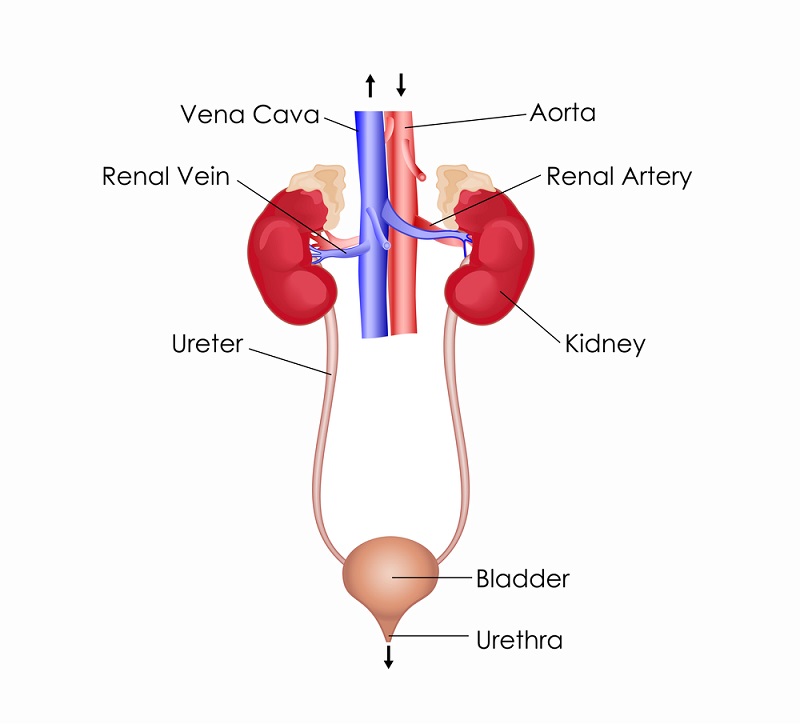
Excretory system diagram
Malfunctions
Kidney stones
Happens when a crystal forms inside the kidney due to lack of drinking fluid and high concentrations of salt. this issue can cause extreme pain and can potentially block off the ureters.
Muscular system
Skeletal Muscle
The most common form off muscle in the body, skeletal muscle is the muscle that is attached to bones and is responsible for moving different parts on their joints. These muscles are generally grouped into opposite pairs of two muscles, which move a specific part in opposite directions. one example of this is the biceps and triceps. The bones and muscles that move them are grouped into the Musculoskeletal system.
Shapes of Skeletal muscle
Spindle
Wide in the middle, and taper down at both ends.
Biceps
Triceps
Quadriceps
Glutes
Flat
Sheet-like muscle that moves a lot differently than other muscles.
Diaphraghm
Triangular
Wide base, and a narrower top part.
Front delt
Rear delt
Mid delt
CIrcular
Round muscle that usually has an opening and closing movement.
Mouth
Anus
Smooth Muscle
Muscle found in certain organs such as the uterus, arteries, veins, and intestines. Organs that are made up of smooth muscle can usually dilate or shrink, and are usually used for the passage of certain fluids or objects. Movement caused by smooth muscle happens without our awareness.
Cardiac
The muscles specifically related to the heart. these muscles are what cause the heart's beating movement and are also an unconscious movement, meaning that they work without our conscious awareness.
Responsible for All types of mechanical movement in the body, such as skeletal movement, or the movement in certain muscles, such as the heart or lungs.

Human Muscular System Diagram
Malfunctions
Muscular dystrophy
This disorder is when the muscles are very progressively weakening over time. this disorder can start showing its symptoms early in childhood, or later in life, such as the teenage years and early twenties. Some symptoms include progressive weakening muscles, difficulty performing actions in practical applications, curvature of the spine, and more.
There is no current cure for this disease, but there are ways to treat it. the msot common way to treat it is building muscle, and regular excersize. Doing this cancels out the effects of the disease and is a very effective way of treatment.
Myopathy
Myopathy is the failure of any muscle that is responsible for voluntary movement by any disease. this is when a certain disease affects the muscles that perform voluntary actions, making the actions delayed, difficult, or not being able to do them at all. some symptoms are delayed movement, weakened muscles, and respiratory impairment.
There currently is no cure for genetic myopathy. howeever, the main method for treatment is diagnosing the disease responsible for the problem early and treating that specific disease accordingly.
circulatory system
Heart
One of the most important organs in the human body, the heart is responsible for taking in Deoxygenized blood and oxygenizing it so that it can be used for all the other organs. The heart functions with beating movements that are what cause the movement of blood. iF the heart stopped funtioning, then the person affected would die.

Human Heart Diagram
Arteries
A large amount of tubes spread around the body that transport blood. Similar to Veins, but they transport Oxygenated air Away from the heart and into organs that need it.
Veins
A large amount of tubes spread around the body that transport blood. Similar to Arteries, but veins transport deoxygenized blood to the heart to be oxygenized.
Blood
A red liquid transported through the body that is used to carry multiple nutrients, oxygen, and other essentials to the various organs in the body.
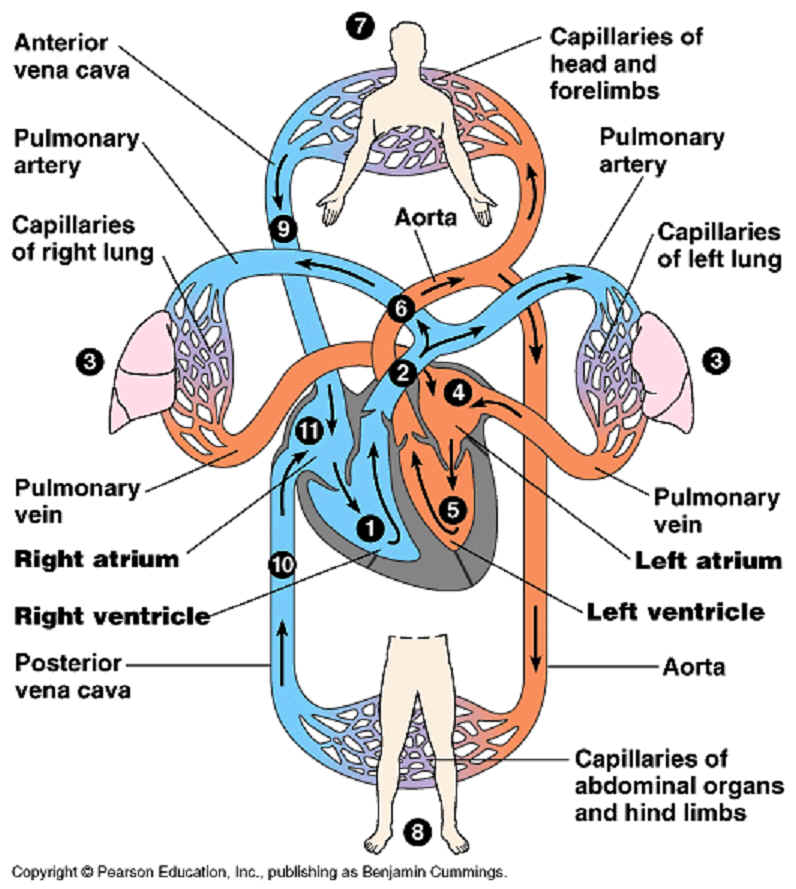
Circulatory system diagram
Malfunctions
Heart Disease
This is caused by a Lack of oxygen transported to organs due to Small/ narrowed Arteries and veins, Which means less blood is transported to and from the heart, which is very dangerous. This can also be casued buy Weak heart muscles, and irregular heartbeats.
Some treatments for Heart disease are Blood thinning medicines, Cholesterol lowering medicines, Nitrates, and others.
High Blood Pressure
High blood pressure, or hypertension, is when the pressure of blood in the veins and arteries is higher than normal. this can cause blood clots, and make it harder for the heart to do its job. This can be caused by Lack of physical activity, Obesity, And other health problems such as diabetes and others. This condition can seriously damage certain organs such as lungs, heart, and brain.
There are many treatments for this, Medicinal and physical. Some medicines that can treat this are Inhibitors, which prevent your vessels from narrowing, And diuretics, which lower the amount of excess water and sodium/salt in the blood to decrease the amoutn of space that the blood takes up.
Responsible for transporting blood to and from the heart, to various organs in the body that need the blood to perform their multiple tasks and functions. This is one of the most important systems in the body.
Digestive System
Stomach
The stomach is a hallow organ in the lower front of the human body, above the waist. it is responsible for digesting food inside it after it is eaten. the stomach is filled with various digestive fluids that help break down solid food.
Esophagus
The esophagus recieves food from the mouth and transports it down to the stomach for digestion.
Small intestine
The small intestine serves as a secondary digestive organ after the large intestine. it also helps absorb nutrients from the stomach. the small intestine also produces some substances that help digest certain foods such as dairy.
Large Intestine
The large intestine is a muscular tube-like structure designated for absorbing vitamins, minerals, and other nutrients from food, and then forming fecal matter so it can exit the waste from the body.
Liver
The liver's job is cleaning and filtering blood passing through the stomach and intestines. the liver excretes a byproduct called bile.
Rectum
The rectum is the last place for waste before it exits the body through the anus. it recieves the waste from the colon and stores it untill exit.
Anus
The anus is a hole at the bottom of the rectum, from which fecal matter exits the body. the opeining is lined with muscles, giving it the ability to open and close.
The digestive system is the system responsible for digesting and consuming food. this system is one of the most important systems in the boyd, as without it all the organs would not get their necessary nutritients.
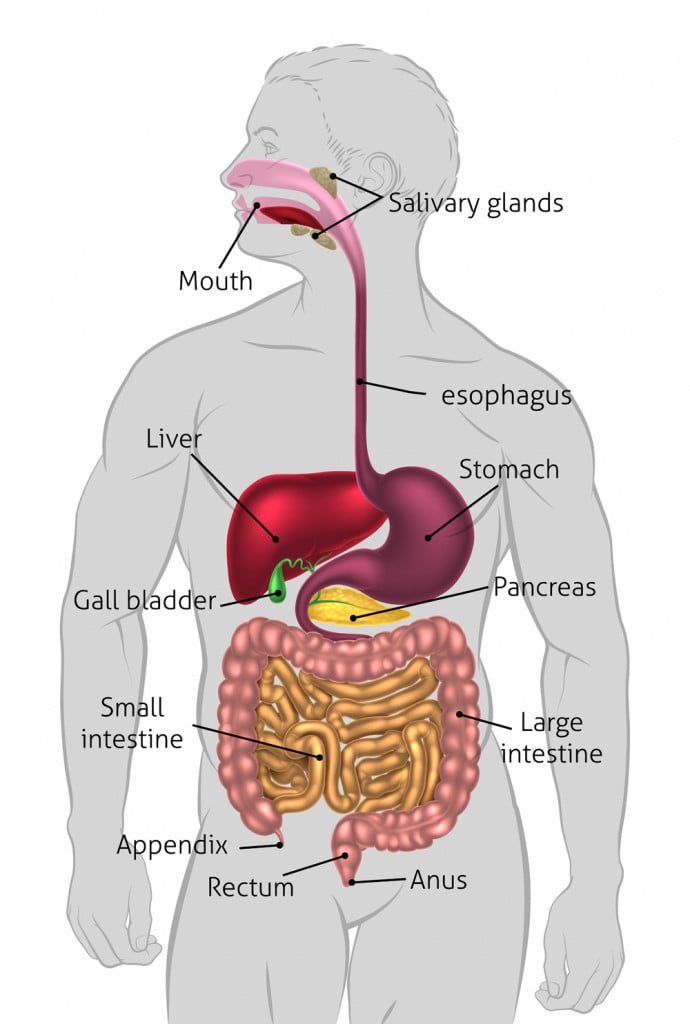
Digestive System Diagram
Malfuntions
Lactose Intolerance
Lactose intolerance is a very common digestive disorder in which the small intestine does not produce an enzyme called lactase. this enzyme is meant to digest lactose, a substance found in milk and dairy products. this lack of that specific enzyme means that consuming dairy products can cause a lot of bad things, such as stomach pain, diarrhea, and gas.
A common treatment for this disorder is taking lactase pills before consuming a dairy produuct. this helps the digestive system break down the lactose enzymes better, and will reduce the unpleasant effects that lactose intolerant people experience when consuming dairy products.
Reproductive system
Male
Penis
A tube or cylinder shaped organ located on the front waist of the male body, in-between the legs. This organ is responsible for urination, and sex. When aroused, the penis glands fill with blood which causes erection and makes the penis elongated and rigid. this allows for penetration into a vagina. Semen also flows through the penis.
Testicles
Two oval-shaped organs hanging behind the penis that produce sperm in the male body and are responsible for fertilising eggs in a female. The testicles also produce testesterone in a male.
Prostate
The prostate is a gland located near the rectum and is responsible for adding additional fluid to sperm, which creats semen.

Male Reproductive System diagram
Female
Uterus
This organ is responsible for holding a baby during pregnancy and can expand and contract. Located above the vagina.
Cervix
The bottom part of the uterus. This organ is responsible for Moving a child to the Vagina during childbirth, and blocking objects from going deeper into the body.
Ovaries
Small, oval/Circle shaped organs on either side of the Uterus. These are responsible for producing eggs and for accomodating Babies in the early stages.
Fallopian Tubes
These organs are tube-like structures that transport eggs from the ovaries into the uterus during pregnancy. Here is where Fertilization of eggs usually happens.
Vagina
A tube like structure that allows for The cervix to have a connection to the outer pert of the body. It can expand and contract, and is used for sexual intercourse, Childbirth, And the menstrual cycle.

Female Reproductive system Diagram
Malfunctions
Female And Male genital Abnormalities
Abnormalities can sometimes, but rarely, occur in both male and female reproductive organs, such as the penis, testicles, vagina, clitoris, and others. Abnormalities in The male reproductive organs can be, but not limited to; twisting, dwarfism, abnormal size, and absence. In the female organs, abnormalities are less common due to the lower complexity of the female organs. However, abnormalities can still occur. Some examples are absences of some parts, such as the urethra, fusion of some parts, and other abnormalities.
Responsible for reproduction in humans, and sexual activity. the organs are different for males and females.
Respiratory system
lungs
Two spongy, tube filled structures located in the upper chest. They Store air inhaled through the nose so it can be used to oxygenize blood sent through the heart.
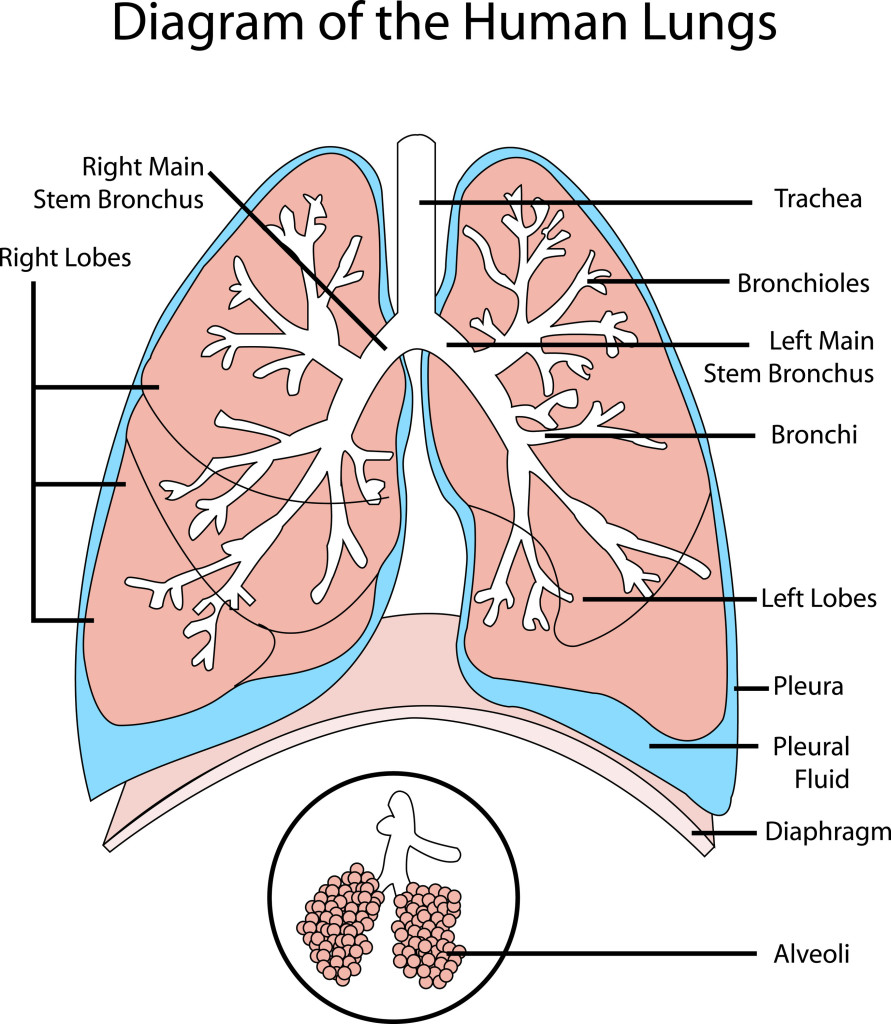
Human Lungs Diagram
Nose

Subtopic
The nose filters air going through, and then it sends air through the nasal cavity, and then through the throat and trachea and into the lungs to be used in the heart to oxygenize blood so it can be used for organs.
Diaphragm
A large muscle that caves in an out to allow for the inhaling and exhaling motions in the lungs
Trachea
A tube- like structure located below
the throat from which air passes through to and from the lungs.
Responsible for breathing, inhaling and exhaling air, and transferring oxygen into the blood and letting out carbon dioxide.
Bronchi
The bronchi are two individual tubes, one for each lung, that the trachea divides into. they serve as passageways for the air coming from outside into the lungs.
Pharynx
Malfunctions
Bronchitis
Affects the larger airways of the lung, making them inflamed and making it very hard to store sufficient air for the lungs to function properly. Some symptoms are coughing, difficulty breathing, and lots of mucus.
Most bronchitis cases clear up on their own with no need of medication after a week or two. this is called acute bronchitis and is the most common form of it. Sometimes the cases can last for more than three months. This type of bronchitis is called chronic bronchitis. No cure has been created, but
Influenza
Influenza is caused by respiratory viruses, such as the Flu, and the recent covid-19. it is one of the most common malfunctions in the human body due to the easy spreading of viruses.
Can be cured over time natrually, but there are multiple vaccines for all sorts of viruses that cause Influenza.
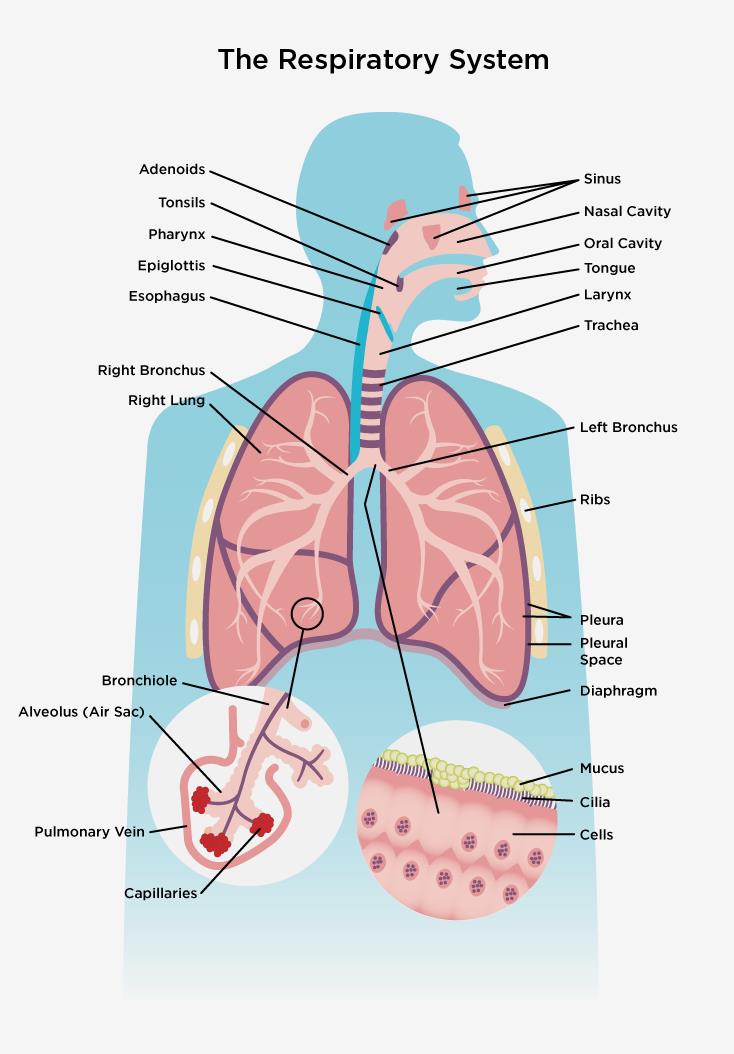
Respiratory System diagram
Nervous System
Brain
Cerebellum
A very important part of the brain. This part of the brain is responsible for voluntary movements such as walking, talking, balance, posture, and more.
Midbrain
The midbrain is the channel from which signals go from the brain to the spine. this part of the brain is responsible for things like vision and hearing.
Brainstem
The bottom part of the brain that connects the brain to the spinal cord, and allows for electrical systems to move to different parts of the body.
The brain is the most important organ in the human body. it controls every single function that occurs in our body. it acts like a very complex supercomputer that can process thoughts and actions and make decisions and movements in fractions of a second, using lightning-fast electrical signals. Without the brain, the human body would be useless.
Spinal cord
Nerves
Nerves are what carry signals from the brain and move them to operate things such as muscles and organs. they can also transmit senses from the skin such as touch, pain, burns, ect.
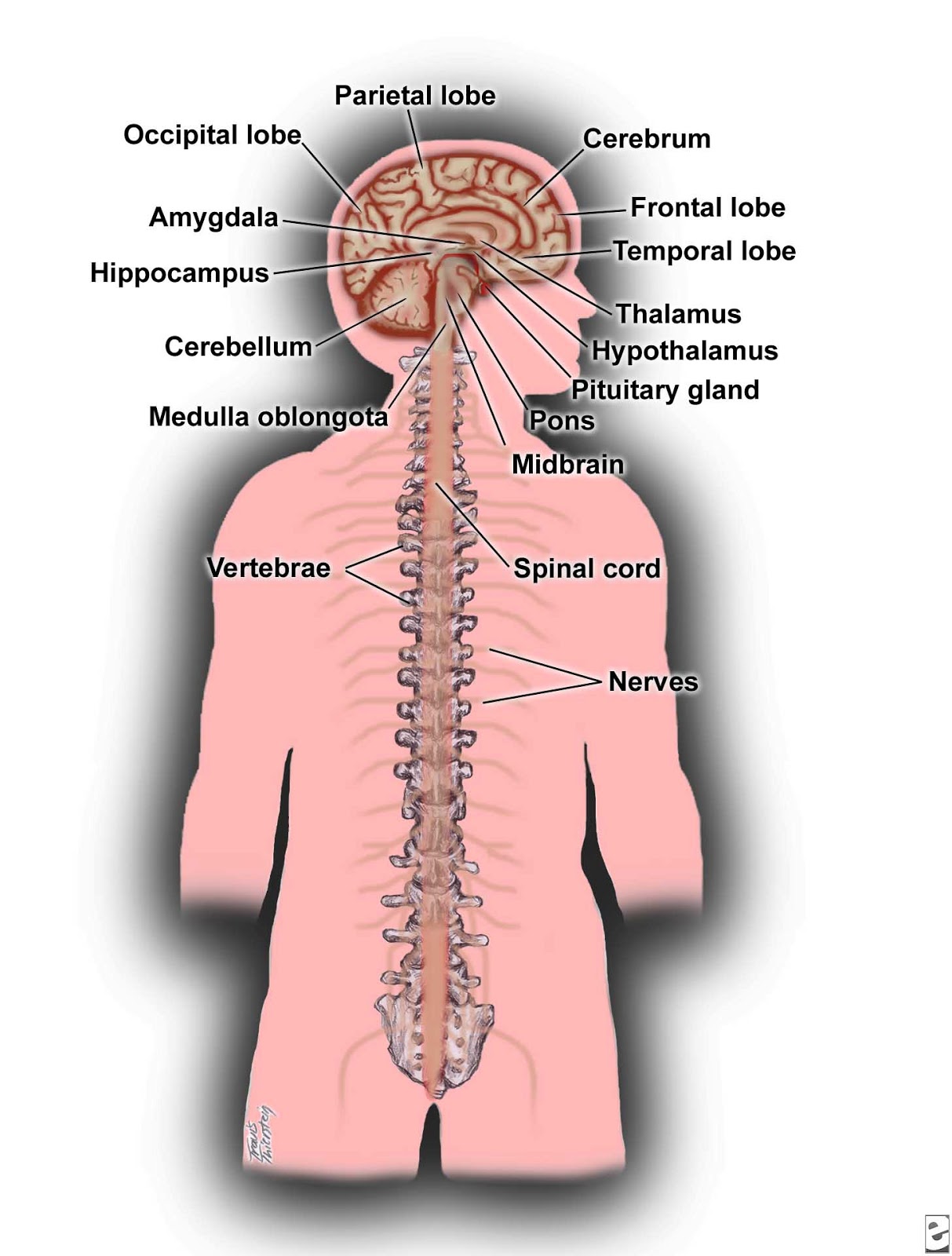
Nervous system diagram
Malfunction
Alzheimer's disease
Alzheimer's disease affects the nervous system by destroying the brain functions gradually over time. this disease makes it difficult to remember things, in the long term, it can make it harder to do very simple everyday tasks.
The technology and treatment involved with helping patients suffering from this disease consis
There are some medicines and technologies used for treating this disease. some examples are galantamine, rivastigmine, and donepezil.
Endocrine system
The endocrine system is the system that controls hormones and growith in the human body, along with other things such as mood, and energy levels.
Hypothalamus
A part of the brain located near the lower base of it responsible for things like mood, appetite, stress, blood pressure, and sleep.
Pineal Body
This is another part of the brain, which is responsible for producing melatonin, which is a substance that, when released, lets the brain know when to fall asleep.
Testicles
Two oval-shaped organs hanging behind the penis that produce sperm in the male body and are responsible for fertilising eggs in a female. The testicles also produce testesterone in a male.
Thyroid
A small gland in your upper neck responsible for releasing hormones that control how your body uses energy. This organ is responsible for controlling a lot of the most important functions in the human body.
Ovary
Small, oval/Circle shaped organs on either side of the Uterus. These are responsible for producing eggs and for accomodating Babies in the early stages.
Thymus
A very important organ in the upper chest that is responsible for producing white blood cells, which kill any suspected abnormal cells in the human body, such as viruses and cancerous cells.

Endocrine System Diagram
Malfuntions
Hyperthyroidism
Hyperthyroidism is when the Thyroid organ produces an oversupply of the thyroid hormones, causing the body to have a much higher metabolism rate. This can cause major weight loss, hand tremors, and a fast, abnormal, or strange heartbeat.
Skeletal System
The skeletal system is the system that is responsible for the bones that make up the structure of the human body. This sytem conists of bones, nerves, and joints.
Periosteum
A rigid outer covering that surrounds bone. this protects and shiels the bone from damage.
Compact Bone
Compact bone is the material under the periosteum that makes up the main bone structure. this is what provides most of the structural support for the body.
Cartilage
A softer rubber-like material that coats the ends of bones and allows for smooth movement without friction.
Spongy bone
The softer inner layer of the bone, found below the compact bone. this is where marrow is stored.
Joints
A joint is the connection of two bones together. Joints are usually movable in a certain direction or on a certain axis. muscles connect to the bones and are what cause movement.
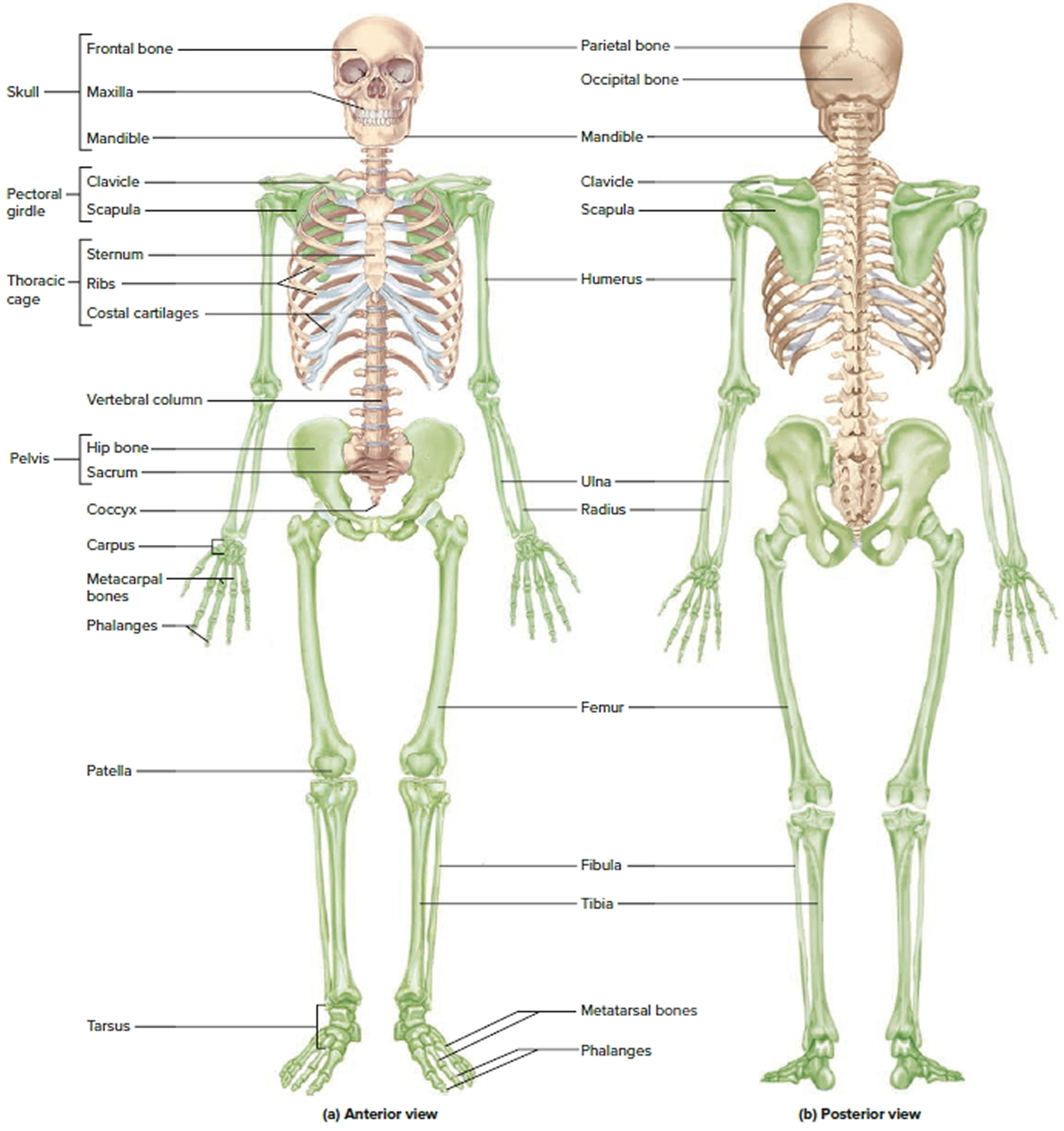
Skeletal System Diagram
Malfunctions
Arthritis
This disorder is more of a common one that affects the cartilage that coats the ends of your joints and would usually make the joint movements smooth and painless. Arthritis is when the cartilage wears down and exposes the compact bone and causing a lot of friction during movements, which results in more energy required to do simple movements. some symptoms are pain while moving limbs, swelling, redness, to name a few.
There are ways to trat arthritis. here are some to name a few: Physical therapy, Medicine, And injected lubrication. Physical therapy is when the muscles and joints are rehabilitated, making the joints work more efficiently. Injected lubrication is a more extreme form of treatment, adn it involves injecting a certain kind of lubricant into the joints to smooth the movements of the bone and muscles.
Integumentary system
Nails
Nails are made of dead keratinocytes and are classified as acessory organs. they are found on the end of every finger and toe, growing out of an end of skin.
Hair
Thin strands of thread-like material that grow out of the skin in almost all areas of the body. however, hair grows in some places more than other
Skin
The skin is the largest organ of the body. it is the surface layer of the body and covers every single part of it. it is made up of three layers: the epidermis, the dermis, and the hypodermis.
dermis
The dermis is the second layer of the skin. this is where most glands in the skin can be found, and also where hair grows. this layer also serves as protection for the inner layers and parts of the body.
Epidermis
The epidermis is the first layer of the skin. this is the layer that is exposed to the outside, and where senses like touch and pain are transmitted.
Hypodermis
The hypodermis is the last layer of the skin, being the deepest layer. this layer is mostly used as lubrication and to reduce friction with the muscles, tissue, and bones under the skin. this is what allows for easy stretch and movement of the skin.
Malfunctions
Acne
Lymphatic system
Lymph nodes
Lymph nodes contain white blood cells, which help filter viruses and diseases coming through lymphatic fluid. Lymph nodes are connected by lymph vessels.
Bone marrow
Bone marrow is what generates stem cells in the body. stem cells are responsible for producing white and red blood cells, keeping the blood healthy.
Thymus
The thymus is what produces cells that help with the body's immune system, such as white blood cells.
Lymph vessels
Lymph vessels Carry things like infections, viruses, waste, and dead skin cells away from muscle and tissue. they also transport lymph in the body to lymph nodes and back to the veins.
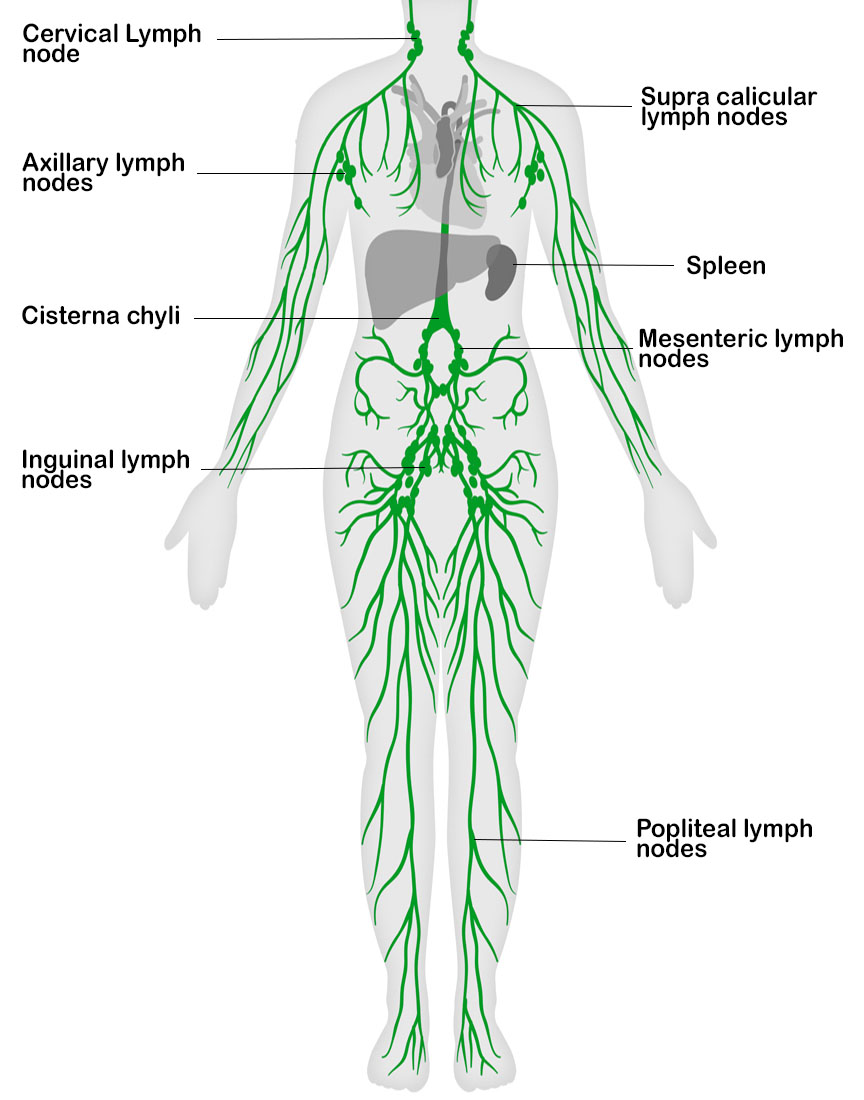
Lymphatic system diagram
Spleen
The spleen is an important organ that fights away any germs that invade the blood and also helps monitor the amount of white and red blood cells in the blood. it also helps prevent blood clots from occuring.
The lymphatic system is responsible for filtering all the fluids in our body, such as blood. it also produces red and white blood cells, helping fight off viruses, germs, and infections in blood.
Malfunctions
Lymphedema
Being one of the most common venous diseases, Lymphedema occurs when a blocked or damaged lymphatic system causes fluid to build up in the limbs, and lymph can't get to the places that it needs to get to, as it usually would.
Lymphedema is not a very hard disease to treat. natural methods include exercise, as moving your limbs regularly can help unblock the fluids inside. some technologies include using an arm pump.